Kyoto is the cultural and historical capital of Japan, with its proliferation of shrines and temples that lie hidden between the concrete constructions of the urban sprawl.

Although archaeological evidence places the first human settlement on the islands of Japan to approximately 10,000 BC, relatively little is known about human activity in the area before the 6th century AD. During the 8th century, when the powerful Buddhist clergy became involved in the affairs of the Imperial government, the Emperor chose to relocate the capital to a region far from the Buddhist influence. Emperor Kammu selected the village of Uda, at the time in the Kadono district of Yamashito Province, for this honor.
The new city, Heian-kyō (平安京 "tranquility and peace capital"), became the seat of Japan's imperial court in 794, beginning the Heian period of Japanese history. Later, the city was renamed Kyoto ("capital city"). Kyoto remained Japan's capital until the transfer of the government to Edo in 1868 at the time of the Imperial Restoration. (Some believe that it is still a legal capital: see Capital of Japan.) After Edo was renamed Tokyo (meaning "Eastern Capital"), Kyoto was known for a short time as Saikyo (西京 Saikyō, meaning "Western Capital").
An obsolete spelling for the city's name is Kioto; it was formerly known to the West as Meaco or Miako (Japanese: 都; miyako "capital"). Another term commonly used to refer to the city in the pre-modern period was Keishi (京師), meaning "metropolis" or "capital".

















